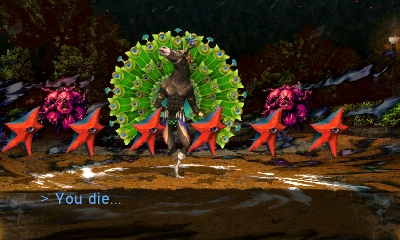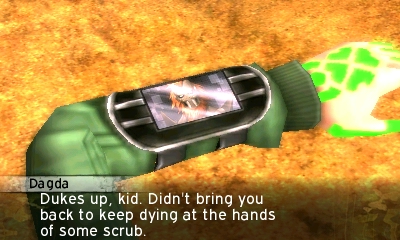Shin Megami Tensei has never been the most forgiving of RPG franchises. Death comes easily, and even random encounters can wipe an unprepared party. The series is beloved for its challenge, forcing players to carefully consider their next step, trying to constantly prepare for the unexpected, and struggling to survive when they find themselves out of their element.
For newcomers, the game can feel deliberately unfair: an experience that rewards long-time fans and experienced players unavoidably penalizes players for failing to perform tasks the game never bothered to explain were possible. Often, a player’s first taste of a new mechanic is when they’re wiped repeatedly, and have no clue how to avoid it.

At worst, they assume that because Megaten is a decades-old JRPG, and go grind for a few hours — killing the momentum of a game that’s designed to present a constantly changing and challenging landscape of abilities, skills and demons. When a SMT game is running at full pace, it’s a wild ride of constant suprises, new enemies and environments challenging the player, who is forced to continually remake their party, recruit new allies, and sacrifice their strongest companions just to keep up.
For new players looking to get up to speed, fans of spinoff series like Devil Survivor, or seasoned RPG veterans looking to get a taste of Persona‘s reclusive older sibling, we’ve prepared the following guide.
Fantastic Beasts and How To Fight Them

Don’t Take A Turn, Press It.
While Apocalypse‘s Press Turn battle system is hardly new — it was first introduced in 2003’s SMT: Nocturne — the only games to make use of it have been either mainline SMT titles or spinoffs, making it an unfamiliar and off-putting concept. While the game explains the most basic aspect of the Press Turn System, attacking an enemy’s weakness to gain extra turns is only the tip of the iceberg.
- The number of actions you have is equal to the number of living party members. This makes healing low-health allies a priority — as losing them can make you waste entire turns trying to summon a replacement, operating with fewer actions each time.
- An attack that is nullified or reflected removes all remaining actions from the attacker’s turn, while a dodged attack removes two actions. If you’re trying to find an enemy’s weakness, using an untested elemental attack is best saved for the last action of the round.
Demon Skills: Proficiency Not Required

The small bar of skill icons at the bottom of each demon’s status screen are slightly deceptive. Rather than a static or scaling change in the power of element-affiliated abilities, these icons represent a small number of relatively minor effects.
- For direct healing skills in the -Dia line, proficiency represents a flat increase in the amount healed. This has not been sufficiently tested on demons, but for the comparable skills on the human protaganist, the change was a little more than 4 extra points of healing per level.
- For buff, debuff and ailment skills, proficiency gives a negligible reduction in MP costs.
- For damaging skills, similar flat increases were calculated, with the human protaganist as the subject. For physical and gun skills, at max proficiency, an increase of 42 damage, for magical skills, 24 damage.
- While not insignificant, any potential penalty for putting a skill on a demon who is negatively proficient in will be masked by the natural traits of that demon: a demon with high physical attack but low physical proficiency can easily do as much damage as a demon with an weak attack stat and high physical proficiency.
Buffing Your Stats for Fun and Profit
Another Megaten series legacy is the suprising effectiveness of status effects and statistic buffs on both enemies and allies. It’s nowhere near as game-breaking as it was in the first Shin Megami Tensei for the Super Famicom, where ammunition with an overpoweringly high chance to paralyze enemies could make the latter half of the title a cakewalk, but they’re strong enough bosses are even balanced around them.
The game doesn’t expect them to be used at every opportunity, but they are a valuable asset, and should not be overlooked; they’re just as valid a solution to beating an impossibly hard boss as any other.
- Sleep, Bind, Panic and Poison abilities can affect friend and foe alike. Because of the nature of the Press-Turn system, curing them should be your first priority. The appropriate antidotes should be kept on-hand in the inventory, but since demons can’t use it normally, a demon with the appropriate skills should be kept on hand in areas or bosses that are particularly spammy with ailment skills. SMTIV introduced the Brand affliction, which prevented all forms of HP and Status recovery, but this was only present in lategame and DLC bosses.
- While stronger foes may resist these ailments, midbosses and overwhelmingly strong random encounters may be designed around weaknesses to these abilities. An enemy with no obvious weaknesses that overpowers a party which can easily handle nearby mobs, for example, will likely succumb to an ailment-based strategy.

Ailments are only half of the picture: buffs and debuffs for Offensive, Defensive and stats affecting Hit and Dodge Chance, are game-changing abilities that should be sought after in allies, and planned for in enemies. While the exact numerical values are tweaked from title to title, on average, damage is at least doubled at the maximum, and halved at the minimum, allowing a prepared hunter to go toe to toe with a boss they might otherwise have assumed they were underleveled for. (Postgame aside, underleveling is almost never the reason for failure: instead, it’s often a misapplied strategy, or a misunderstood mechanic.)
- -kaja abilities raise the party’s stat by a single ‘level’, while -nda effects lower it by a single level. In Apocalypse, three categories of statistics can be affected in this way: overall offense, overall defense, and agility, which affects the % chance to hit and dodge attacks. These effects scale the same for all units, enemy, ally or boss.
- In early and mid-game, where access to these buff abilities are limited and will only raise one stat category at a time, players should not try to amass a large number of buffs in all areas. Much more effective is pairing allied buffs with enemy debuffs in the same stat. Against an enemy who specializes in single hit-large damage attacks, pairing Rakukaja’s defensive boosts with Tarunda’s offensive debuffs will keep your party alive long enough to mount an attack. Likewise, an enemy who uses multi-hit attacks can be punished by using these skills to give your team at least one guaranteed dodge, reducing their damage and moves per turn all at once.
This is part of a series in GameSkinny’s ongoing coverage of SMTIV: Apocalypse. Next, we’ll be covering Apocalypse’s unique system of party-building in our beginner’s guide to Negotiation and Fusion. If you have any questions, corrections, or requests for guides on particular subjects, please leave a comment below.






